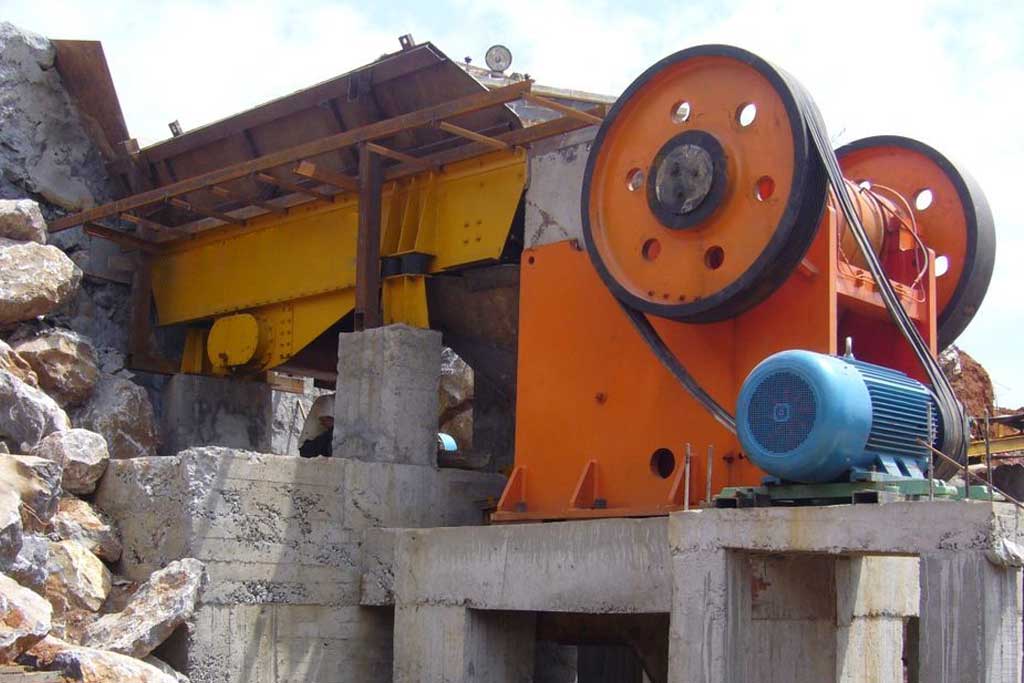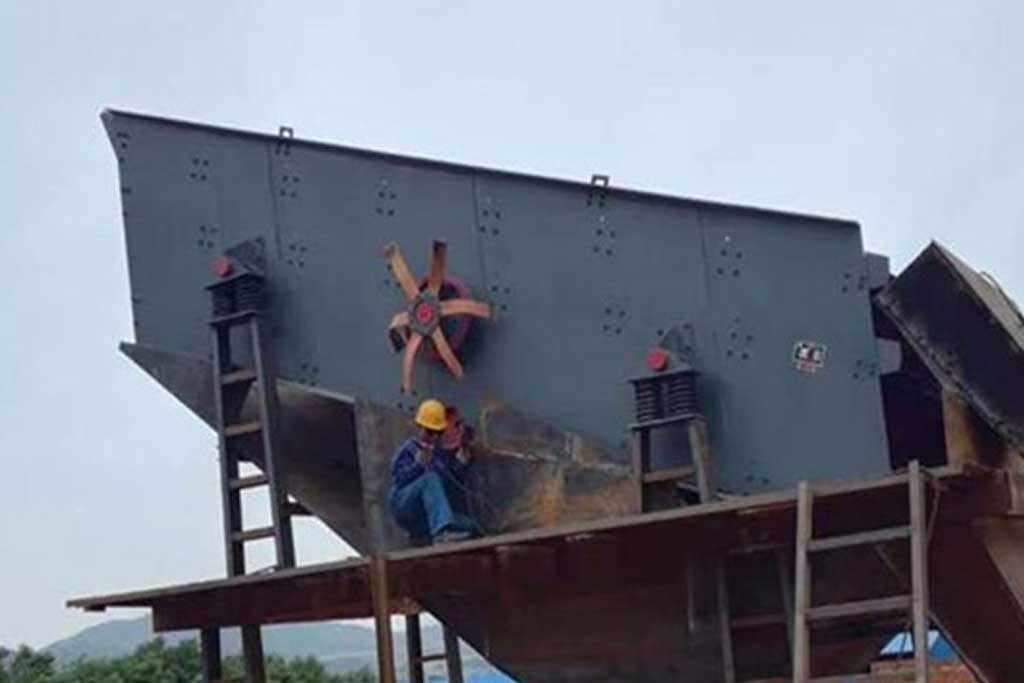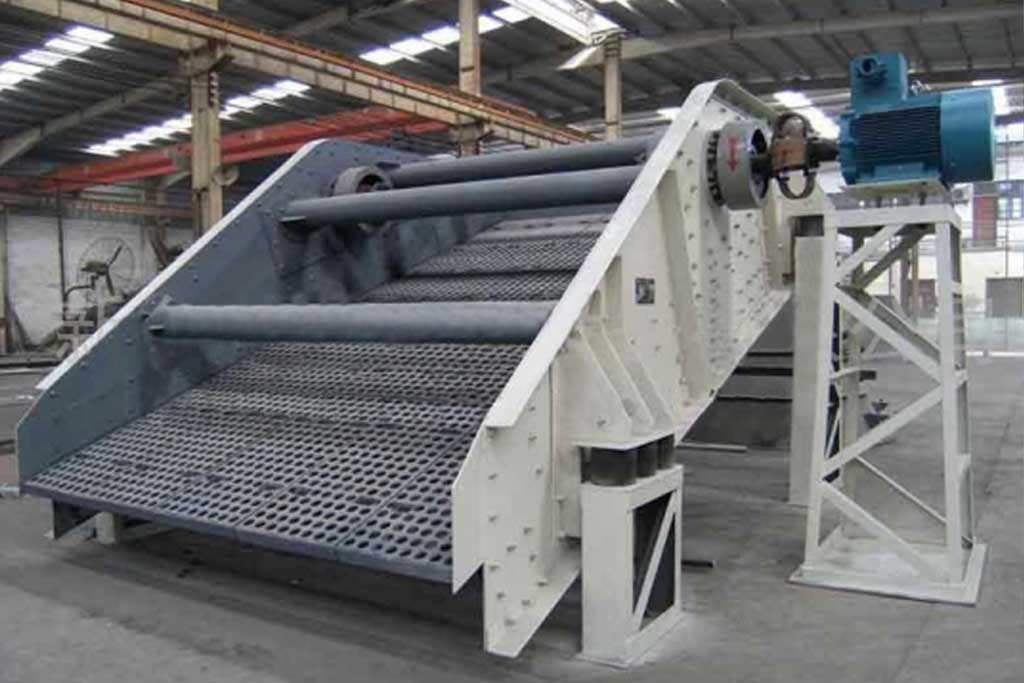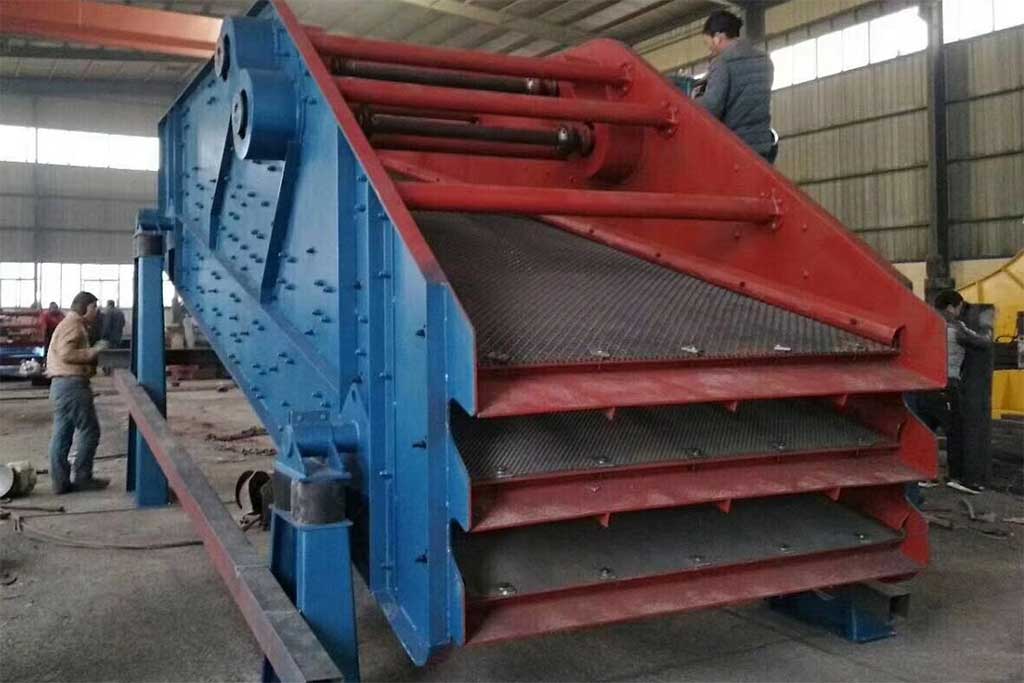Single-Axis Vibrating Screen
The mine-used single-axis vibrating screen adopts vibrating motor excitation, rubber spring damping, high wear-resistant material sieve plate, sealed screen box and other advanced technologies at home and abroad and advanced self-synchronized vibration principle. With the characteristics of high efficiency, it is a kind of vibration screening equipment suitable for sinter, natural ore, coke and other powdery materials.

Single-axis Vibrating Screen
The trajectory of the single-axis vibrating screen is a circle. There are 17 specifications in the whole series, which can be used for auxiliary or independent screening operations in mining, coal, electric power, construction, chemical, and other departments for dry classification of medium-grained materials. The sieving machine with rubber sieve plates is particularly effective in classifying coke materials.
The single-shaft vibrating screen has a simple structure, convenient maintenance, reliable operation, high screening efficiency, screen penetration, and good performance;
The installation forms include the hanging type and seat type. It is a multi-layer material screening device. The number of layers is single-layer or double-layer, and can be customized according to the required number of layers;
The transmission form is divided into left and right, and the sieve plate has punching and weaving (including a rubber screen).
Read More: Guide to the Best Vibrating Screen in 2023

Structure Type of Single-Axis Vibrating Screen
The single-axis vibrating screen for mine is composed of a screen box, vibrator, spring, and other parts. There are two types of support: suspension support and seat support, suspension support, and the screen surface is fixed on the screen box; the screen box adopts a welded structure, which is firm and reliable and is suspended or supported by springs. Driven by the pulley to rotate at high speed.
On the main shaft of the vibrator, except for the eccentricity in the middle part, an eccentric wheel with adjustable eccentric weight is installed at both ends of the main shaft, or an eccentric wheel is also made at both ends of the shaft, and then an ellipse wheel with adjustable core weight is installed. The disc with eccentric weight is installed on the main shaft and rotates with the main shaft to generate centrifugal inertial force so that the screen box that can vibrate freely will vibrate in an approximate circular track; the distance between the eccentric weight and the center line of the bearing is the excitation eccentricity.

Working Principle of Single-Axis Vibrating Screen
The motor drives the vibrator through the V-belt, and the transmission shaft rotates at a certain speed, so the eccentric shaft and the eccentric mass of the eccentric wheel generate inertia. Under the action of inertia, the screen box moves in an approximately circular arc, and the spring supports the screen box. The impact force is transmitted to the foundation by the sieve during operation. A damping device is installed horizontally on the spring seat to limit the lateral swing of the sieve and reduce the vibration amplitude of the sieve when it resonates.

Working Principle of Single-Axis Vibrating Screen
The motor drives the vibrator through the V-belt, and the transmission shaft rotates at a certain speed, so the eccentric shaft and the eccentric mass of the eccentric wheel generate inertia. Under the action of inertia, the screen box moves in an approximate circular arc, and the spring supports the screen box. The impact force is transmitted to the foundation by the sieve during operation. A damping device is installed horizontally on the spring seat to limit the lateral swing of the sieve and reduce the vibration amplitude of the sieve when it resonates.
Selection Information
Single and double vibrating screen, and both hanging and pedestal of the points.
Woven mesh sieve structures and rubber sieves, such as the use of perforated screens can be designed.
The motor can be mounted on the left or right, no special installation is required by the installation diagram.
The motor rated voltage of 380V, such as the selection explosion or different rated voltage of the motor, please specify when ordering.
The selection is subject to change surface inclination requirements for the seat-style screen can be designed for hanging the screen by the user by adjusting the length of the rope-hanging device to achieve.
A total of 32 M20 foundation bolts were supplied by the user.
Technical performance and parameters
| Model | Layers | Area m2 | Angle ° | Mesh size mm | Structure | Feed size mm | Processing capacity t/h | Vibration times l/min | Double amplitude mm | Motor Model | Motor Power Kw | Size length x width x height mm | Weight Kg | Feeding end | Discharge end | Feeding end | Discharge end | Maximum Split Parts size length x width x height mm |
| DD918 | 1 | 1.6 | 20 | 1-25 | to weave | ≤60 | 10-80 | 1000 | 5-6 | Y100L-4 | 2.2 | 1926×1418×1809 | 440 | ±148 | ±148 | ±740 | ±740 | 2150×1418×575 |
| 2DD918 | 2 | 1.6 | 20 | 1-25 | to weave | ≤60 | 10-80 | 1000 | 5-6 | Y100L-4 | 2.2 | 1926×1418×2013 | 600 | ±210 | ±210 | ±1050 | ±1050 | 2200×1418×630 |
| ZD918 | 1 | 1.6 | 20 | 1-25 | to weave | ≤60 | 10-80 | 1000 | 6 | Y100L-4 | 2.2 | 1926×1737×1434 | 553 | ±147 | ±147 | ±735 | ±735 | 2150×1643×1430 |
| 2ZD918 | 2 | 1.6 | 20 | 1-25 | to weave | ≤60 | 10-80 | 1000 | 6 | Y100L-4 | 2.2 | 1926×1737×1434 | 702 | ±147 | ±147 | ±735 | ±735 | 2150×1643×750 |
| ZD1224 | 1 | 2.9 | 20 | 6-40 | to weave | ≤100 | 60-180 | 850 | 6-7 | Y112M-4 | 4 | 2471×2109×1334 | 1130 | ±308.7 | ±308.7 | ±1544 | ±1544 | 2500×2150×1340 |
| 2ZD1224 | 2 | 2.9 | 20 | 6-40 | to weave | ≤100 | 60-180 | 850 | 6-7 | Y112M-4 | 4 | 2560×2099×1780 | 1545 | ±154.4 | ±154.4 | ±772 | ±772 | 2600×2200×1730 |
| ZD1224J | 1 | 2.9 | 20 | 11×42 13×42 26×35 | to weave | ≤100 | 95-145 | 850 | 6-7 | Y112M-4 | 4 | 2471×2149×1334 | 1086 | ±308.7 | ±308.7 | ±1544 | ±1544 | 2500×2150×1340 |
| 2ZD1224J | 2 | 2.9 | 20 | 13×42 26×35 43×58 | to weave | ≤100 | 100-180 | 850 | 6-7 | Y112M-4 | 4 | 2551×2149×1780 | 1637 | ±154.35 | ±154.35 | ±771.35 | ±771.35 | 2600×2200×1730 |
| ZD1530 | 1 | 4.5 | 20 | 6-50 | to weave | ≤100 | 90-300 | 920 | 6-7 | Y132S-4 | 5.5 | 3071×2619×1566 | 1650 | ±404.9 | ±404.9 | ±2023 | ±2023 | 3100×2690×1570 |
| 2ZD1530 | 2 | 4.5 | 20 | 6-50 | to weave | ≤100 | 90-300 | 850 | 6-7 | Y132S-4 | 5.5 | 3170×2619×2250 | 2260 | ±202.1 | ±202.1 | ±1010.5 | ±1010.5 | 3200×2690×2250 |
| ZD1530J | 1 | 4.5 | 20 | 11×42 | to weave | ≤150 | 148 | 850 | 7 | Y132S-4 | 5.5 | 3071×2674×1566 | 1875 | ±404.6 | ±404.6 | ±2023 | ±2023 | 3100×2690×2250 |
| 2ZD1530J | 2 | 4.5 | 20 | 13×42 26×35 43×58 | to weave | ≤100 | 160-280 | 850 | 7 | Y132S-4 | 5.5 | 3170×2683×2250 | 2653 | ±202.1 | ±202.1 | ±1010.5 | ±1010.5 | 3200×2690×2250 |
| ZD1540 | 1 | 6 | 20 | 6-50 | to weave | ≤100 | 123-380 | 850 | 7 | Y132M-4 | 7.5 | 4069×2651×2028 | 2070 | ±595 | ±595 | ±2975 | ±2975 | 4000×2505×2025 |
| 2ZD1540 | 2 | 6 | 20 | 6-50 | to weave | ≤100 | 125-380 | 850 | 7 | Y132M-4 | 7.5 | 4069×2651×2656 | 2850 | ±267.2 | ±267.2 | ±1336 | ±1336 | 4200×2600×2660 |
| ZD1836 | 1 | 6.5 | 20 | 6-50 | to weave | ≤150 | 135-440 | 850 | 7 | Y160M-4 | 11 | 3669×3016×1807 | 1960 | ±525 | ±525 | ±2625 | ±2625 | 3670×2990×1807 |
| ZD1836J | 1 | 6.5 | 20 | 43×58 87×104 | to weave | ≤150 | 250-600 | 850 | 7 | Y160M-4 | 11 | 3069×3100×1807 | 4754 | ±525 | ±525 | ±2625 | ±2625 | 2670×2990×1807 |
| ZD2160 | 1 | 12 | 20 | 10-50 | to weave | ≤150 | 230-540 | 900 | 8 | Y1820L-4 | 22 | 6080×3776×3075 | 6529 | ±1056 | ±1056 | ±5280 | ±5280 | 6676×2420×1990 |
Note: The processing capacity in the table is given by the dry classification of the ore with a loose density of 1.6t/m3 according to the maximum and minimum sieve holes of the upper sieve surface. The sieve size particle content accounts for 25%, and the screening efficiency is 80%.
In the table, the largest disassembled parts with a yield of the sieve machine less than 2t are not listed.
Read More: Vibrating Screen Wikipedia